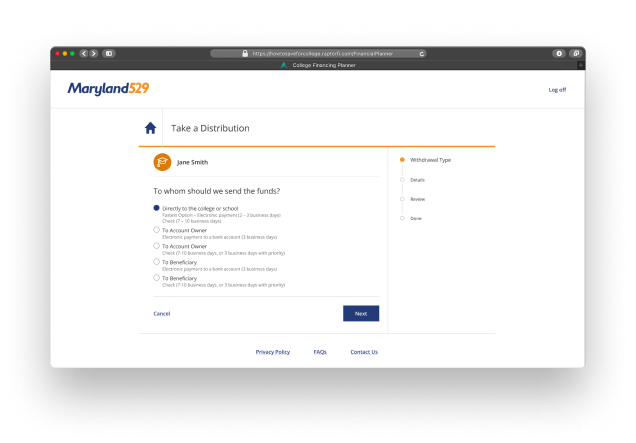
Requesting A Distribution
You can quickly and securely take a distribution whenever you are ready.
You can request a distribution at any time and have your money between two and ten business days, depending on how you choose to take a distribution.
Options for Distributions
Your money, your way.
Your Maryland College Investment Plan has multiple options for you to take a distribution.
Be sure you have the following information handy:
- Information needed to identify your Investment Plan account.
- The amount you want to withdraw.
- For direct to school transfers you'll need the beneficiary's student ID number associated with their school.
Send directly to a participating school
Your account offers a convenient way to send your savings directly to a school electronically.
$10 fee applies to direct to school transfers
Electronic transfers to a bank account
Transfers to an account owner or beneficiary's bank account offers the benefits of fast and efficient distribution processing and enhanced security.
Send a check
For those that prefer a traditional method, our Plan offers the flexibility to send funds via check.
learn more about distributions
Distributions FAQs
You will have the option to:
- Send electronic payments directly to colleges, universities, and other eligible postsecondary schools.*
- Request a check to be sent directly to colleges, universities, and other eligible postsecondary schools.*
- Request a check made payable to yourself to be sent to your address on record.
- Send funds electronically to your existing bank account on file.
- Request a check made payable to the beneficiary and sent to the beneficiary's address on record.
- Send funds electronically to the beneficiary's existing bank account on file.
Any distribution request of $100,000 or more requires the Distribution Request Form and will also require a Medallion Signature Guarantee.
It is important to note that tax reporting is dependent upon the payee of the distribution. If the distribution is made payable to the account owner, the tax reporting will be issued under the account owner's Social Security number and mailed to the account owner's address on file. If the distribution is payable to the beneficiary or an eligible postsecondary school, the distribution will be reported under the beneficiary's Social Security number and the tax form will be mailed to the beneficiary's address on file.
*If an electronic payment or a check is sent directly to the school, the beneficiary will be the taxable party for the distribution and will receive a 1099-Q for the current tax year. Please note distribution checks for K-12 schools should be made payable to the account owner or the beneficiary.
We do our best to give you access to your distribution as quickly as possible.
Distribution requests received in good order are processed the day they are received if they are received prior to 4pm ET on a business day. If the request is received after 4pm ET or on a holiday, weekend, or other non-business day, the request will be processed the following business day.
The quickest way to distribute funds to a school is to request an online electronic payment directly to a postsecondary school. This request typically takes two business days.
Alternatively, you can request an online electronic payment to a bank account on file for you or your beneficiary. This option typically takes three business days.
Finally, you can request a check payable to yourself, your beneficiary, or a postsecondary school. Checks typically take 7 to 10 business days to be received in the mail, after the distribution request has been processed by the Investment Plan.
You can use the funds in your 529 account to pay for qualified education expenses as defined in the Internal Revenue Code.
For the distributions to be federally tax-free, visit our Approved Uses tool for a detailed overview of the options available.
No, you are responsible for satisfying the IRS requirements for proof of a qualified distribution, which include retaining any paperwork and receipts necessary to verify the type of distribution you receive.
Each January, the Maryland College Investment Plan issues Form 1099-Q for any distributions taken during the previous calendar year. This form is mailed to the account owner if the distributed assets were mailed or electronically sent to the account owner. If the assets were sent to the beneficiary or the eligible postsecondary school, then the 1099-Q is mailed to the beneficiary's address on file. The account owner can access any account owner 1099-Qs online by logging in to their account online and clicking Profile & Documents from their dashboard.
